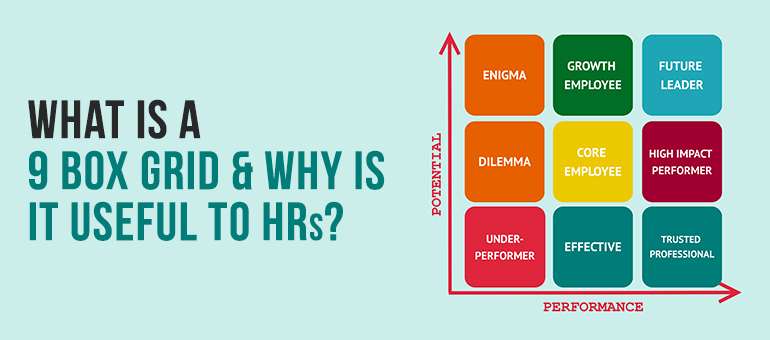The field of talent management has recently observed continuous growth. This has led to the rise of a 9-box grid system with 9 specific dimensions. It has been extensively adopted as the best way of evaluating an individual’s overall performance management potential. The 9-Box Grid system for performance evaluation is a powerful tool that has helped businesses classify and envision capabilities in an impartial and orderly way permitting skill identification to be achieved quicker. Predictive Success CEO David Lahey from his experience asserted that the model works fine 95% of the time and may bump into trouble only when communication isn’t transparent. It is a popular tool for employee development, talent mobility, and succession planning.
What is a 9-box grid system?
A 9-box grid consists of 3 boxes placed on top of each other in 3 rows. Employees are plotted against 2 scales: performance (present) and potential (future). Generally, proper HR software consists of integrated 9-box grids that allow a more agile and inclusive technique to skill planning and development. During an organization’s leadership meeting, the names of personnel are positioned in one of the boxes according to every worker’s degree of potential and performance. 3 scores of poor, moderate, and high, or other versions of similar terms are used for both performance and potential. For example, the scores for performance can be vertical along a side of the box, while scores for potential can be horizontal or at the lowest or topmost position. When a worker is rated as a mediocre performer with high potential, the worker could move into the central box at the top row to signify the central box for performance and the topmost box for potential.Mapping workers against the performance potential matrix enables businesses to quickly observe where their high potential and high-performance personnel are. It is to prevent missing out on taking action on them.Executive leadership and worker productiveness are measures of performance. Potential is evaluated by looking forward to an employee’s degree of employee engagement, the exhibition of leadership competencies or management traits, or contribution toward an innovation culture.The nine-box grid is utilized for human capital management (HCM). It generally comes along with performance management and talent management software programs. Most sellers, such as Oracle Corp., SAP SuccessFactors, Workday, etc. offer an option of a configurable nine-box grid in their software program.Why is the 9-box grid system useful to you?
Enables you to coordinate everything faster –
The remarkable aspect about 9-box grids HR Software is that it is quick to install and easy to use. With the feature of intuitive drag and drop, you can quickly and easily arrange personnel in your talent pools again and again. The pictorial format additionally makes it easier to look for gaps, so that you can insert suitable plans to fill them.It strengthens communication –
This simple but robust tool acts as a substructure for communication with managers about skills. Also, it encourages crucial discussions that are unlikely to occur without it. It permits managers to discover both strengths and weaknesses in their talent pools. At the same time, it offers lucidity over the state of the skill across the entire organization, assisting to eliminate obstacles to worker movement.Offers a new outlook –
Since the procedure to allocate employees to different sections of the grid is collaborative, managers make use of the opinions or evaluations of others. Managers, when working collectively with everyone, they benefit from a new perspective. Therefore a better objective evaluation of employees’ development and potential can be made.Helps you in future planning –
After an effective conversation, the important step is to utilize the information to enhance succession planning and work career development. This is so that you can make sure continuity and growth, and move forward your business to the subsequent level. For example, personnel recognized as having high potential performance and displaying an indication of becoming future leaders, or successful, will need to be nurtured so that they continue to be challenged and rewarded. Maybe they’re those who might be essential to the achievement of an upcoming venture or fill the vacancy of a supervisor who has left. Researchers from Harvard have claimed that corporations with appropriate procedures in place will apprehend 3% to 5% of their personnel as high potential individuals who execute assigned responsibilities beyond expectations.Offers employee development opportunities or training requirements –
Individuals who are comparatively weaker in the field, or people who aren’t suitable for their present position, can also be highlighted in this system. Employees having high potential but low performing skills may need motivation, through a stretch assignment, mentoring, or an alteration in role in the company. Candidates constantly allotted to the low potential and low-performance field will need a different approach and may require additional investigation.Limitations of 9-box Grid Model
Inadequate Measurements –
Every model comes with both benefits and limitations. Some people regard performance and potential too similar a category to be independently assessed since one often directly affects the other.Affected to Biasness –
Other people dwell on the condition that the grid system encourages unfair worker labeling, which then becomes hard to take off and executives might wrongly use those labels as shortcuts while discussing employees.How to overcome these limitations?
If managers simply outline how they assess potential from the outset and use the grid fluidly so that the workers don’t get categorized, it stays a useful device for discussion.Conclusion
The 9 box grid is a beneficial tool to manage all the personnel in an organization. The HR and executives must set up what they want out of the process earlier than they start. As a boss, you need to make sure you act upon the discussion generated from the process, and not just use the grid casually.
Facebook
Twitter
LinkedIn
Pinterest
Email



